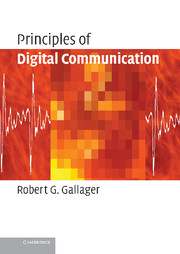Book contents
- Frontmatter
- Contents
- Preface
- Acknowledgements
- 1 Introduction to digital communication
- 2 Coding for discrete sources
- 3 Quantization
- 4 Source and channel waveforms
- 5 Vector spaces and signal space
- 6 Channels, modulation, and demodulation
- 7 Random processes and noise
- 8 Detection, coding, and decoding
- 9 Wireless digital communication
- References
- Index
2 - Coding for discrete sources
Published online by Cambridge University Press: 05 June 2012
- Frontmatter
- Contents
- Preface
- Acknowledgements
- 1 Introduction to digital communication
- 2 Coding for discrete sources
- 3 Quantization
- 4 Source and channel waveforms
- 5 Vector spaces and signal space
- 6 Channels, modulation, and demodulation
- 7 Random processes and noise
- 8 Detection, coding, and decoding
- 9 Wireless digital communication
- References
- Index
Summary
Introduction
A general block diagram of a point-to-point digital communication system was given in Figure 1.1. The source encoder converts the sequence of symbols from the source to a sequence of binary digits, preferably using as few binary digits per symbol as possible. The source decoder performs the inverse operation. Initially, in the spirit of source/channel separation, we ignore the possibility that errors are made in the channel decoder and assume that the source decoder operates on the source encoder output.
We first distinguish between three important classes of sources.
• Discrete sources The output of a discrete source is a sequence of symbols from a known discrete alphabet X. This alphabet could be the alphanumeric characters, the characters on a computer keyboard, English letters, Chinese characters, the symbols in sheet music (arranged in some systematic fashion), binary digits, etc. The discrete alphabets in this chapter are assumed to contain a finite set of symbols.
It is often convenient to view the sequence of symbols as occurring at some fixed rate in time, but there is no need to bring time into the picture (for example, the source sequence might reside in a computer file and the encoding can be done off-line).
This chapter focuses on source coding and decoding for discrete sources. Supplementary references for source coding are given in Gallager (1968, chap. 3) and Cover and Thomas (2006, chap. 5). A more elementary partial treatment is given in Proakis and Salehi (1994, sect. 4.1–4.3).
[…]
- Type
- Chapter
- Information
- Principles of Digital Communication , pp. 16 - 66Publisher: Cambridge University PressPrint publication year: 2008
- 3
- Cited by



